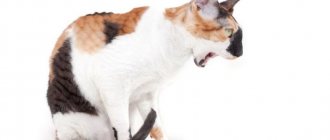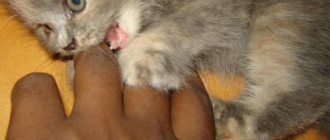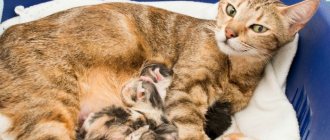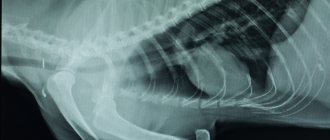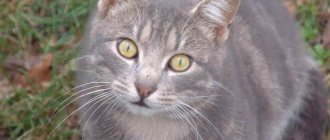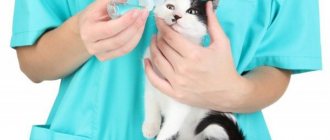11475Administration
2
It is very important for the owner to notice the signs of childbirth in a timely manner for the owner, because this is what makes it possible to accurately determine the duration of the birth process and, if necessary, provide assistance to the pet. If you miss the start of lambing, it may be difficult to determine whether intervention is necessary. If the animal’s condition is good and the process is going correctly, then intervention is not required. When the birth of kittens is delayed, a veterinarian is necessary. After examining the four-legged woman in labor, he will determine the need for one or another assistance.
Complications during childbirth are more often observed in purebred animals and too young females, whose body has not yet fully formed. Outdoor cats, which have the opportunity to constantly be in the fresh air and spend time actively, rarely encounter problems during pregnancy and lambing due to the fact that their bodies are strong and well-trained. He can easily bear the load and easily prepares himself for the birth of kittens without any intervention. However, signs of impending birth in a cat that lives at home should alert their owners. If there is a week left before the birth of the offspring, a female who gives birth not for the first time may have completely absent signs.
© shutterstock
Stages of gestation of kittens
A cat can become pregnant for the first time at the age of six months, when the first heat usually appears. But most veterinarians believe that only a strong female who is at least 12 months old can bear healthy kittens. Pregnancy occurs in 3 stages:
After mating, the cat's genital swelling is visible, but this does not mean that she is fertilized. The first signs will clearly appear from the 3rd week:
- the pet becomes lethargic, eats poorly, moves little, sleeps more;
- within 2-3 days she vomits repeatedly;
- nipples enlarge and acquire a bright pink color or, conversely, become lighter;
- When palpating the cat's genitals, the veterinarian notices an enlarged uterus.
During the middle period of pregnancy, the animal noticeably gains weight as the fetus actively develops. By the 6th week, the amount of amniotic fluid increases and the kittens begin to move for the first time. By stroking your pet's belly, you can carefully “feel” the future children.
At 7-9 weeks, the cat’s excitement intensifies, she fussily rushes around the apartment in search of a future “nest”. Kittens move actively, which is especially noticeable in a sleeping cat. The animal restlessly licks its genitals.
Signs of approaching labor
Precursors of labor in primiparous cats usually begin earlier than in those who have already given birth. Therefore, if the pet is young and has not given birth to kittens, there is no need to panic if the prenatal condition changes; it is likely that there is still some time before giving birth.
From the point of view of feline physiology, the following signs of beginning labor are distinguished:
- within 1-3 days, the cat’s body temperature drops to an average of 37°C;
- within 1-2 days, the external genitalia swollen lick themselves . Mucous-pink discharge may appear without a pungent odor - sometimes it seems that the cat is licking the genitals without stopping;
- activity decreases, apathy appears;
- the mammary glands visually noticeably , the local temperature rises noticeably (the abdomen becomes hot, but there are no signs of illness);
- the appearance of colostrum in the nipples - if you press the nipple a little, a white, barely yellowish liquid appears;
- she drinks water as usual, her appetite is preserved, but she eats very little and mostly soft or liquid food;
- approximately 2 expected days before birth, active movements , especially when the cat is sleeping. This is explained by the fact that kittens literally turn over in the womb, taking a comfortable position for birth. This continues almost until childbirth.
Preparing for childbirth
Often pets give birth so quietly and carefully that the owner does not even have time to notice any traces of the event. But in case of complications, the pet may need human help, so it is better to find out in advance how to determine that a cat is giving birth and carefully prepare for this event.
By the end of the third trimester of pregnancy, a caring owner should stock up on items and medications that may be useful during childbirth, as well as immediately after it. So, if you are worried about the health of your pet and her future children, you should definitely have on hand at the time of lambing:
- Oxytocin is a drug that stimulates labor in case it is delayed.
- Sterile latex gloves.
- Sterile scissors and thread.
- Antiseptic agents in powder and liquid form intended for animals.
- Zelenka and cotton balls for treating the umbilical cord.
- A special suction, bulb or pipettes to remove fluid from the kitten’s respiratory tract if it begins to choke.
- Clean terry towels for drying kittens.
- Phone veterinarian for urgent consultation.
- Cat milk replacer (she may not get it).
- A durable cardboard box for kittens with low sides (it doesn’t matter whether you buy it at a pet store or make it yourself - the main thing is that the cat can freely “travel” from and to it without disturbing the kittens).
Giving birth to a cat at home
In general, you should not interfere with childbirth if the expectant mother does not need help. But again, you need to control the entire process. All births are divided into three categories according to complexity. See below for more details.
Easy birth
This is a normal birth where the cat does not require human assistance. In this case, there is no need to interfere with this natural process.
Middle birth
In this case, the cat and its offspring require minimal human assistance. For example, it is necessary to induce labor, pull the kitten out of the birth canal, or open the bladder in which the baby was born. All this should be done only with sterile things, always wearing gloves.
If the kitten does not squeak after the cat has licked it, you should resuscitate it. To do this, try to clear the airways. If it doesn’t help, then rub it on the chest and back with a towel for 3-4 minutes. You can try to gently shake the kitten like a thermometer, but this is a last resort.
Difficult birth
In this case, a caesarean section may be necessary. An ordinary person is helpless in this case. Here you need to call a veterinarian at home. And if even earlier, during the examination, it was known that the birth would be difficult, then you should take the cat to the veterinarian in advance so that he can professionally deliver the baby.
Induction of labor
The average interval between the birth of kittens in a cat is from 5 to 60 minutes. Therefore, there is no need to induce labor until the deadline has passed. If there is still a need for this, then you need to use oxytocin. If your pet weighs 5 kg, you should give 0.3 ml of this drug once an hour. There is no need to administer the drug more than 3 times, as this can lead to serious problems, for example, weakening of the body.
In some cases, your mustachioed pet may need medical assistance, so in addition to the tools, you should prepare some medications.
Let's work together to make the unique material even better, and after reading it, we ask you to repost it on a social network convenient for you. net.
Signs of approaching labor
So, you have already purchased and prepared everything you need, all you have to do is wait for the birth to begin. And here the question arises again: how to understand that a cat is giving birth; signs of the end of pregnancy seem to be obvious, but an inexperienced owner needs additional information in order to have time to come to the pet’s aid at the crucial moment.
Signs that a cat is about to give birth are:
- the animal shows strong anxiety, meows loudly, looks for a comfortable, often hidden place to relieve itself of the burden;
- the mammary glands greatly increase in size, the skin around the nipples dries and peels;
- 24 hours before lambing, the pet experiences lactation;
- body temperature drops to 37 degrees and below;
- on the day of lambing, the pet completely loses interest in food;
- a few hours before lambing, the cat begins to bend its back frequently;
- the animal licks the genitals, from which a malicious odor often emanates (sometimes you can notice the release of the birth plug, which is a mucous clot - transparent or having a pinkish, yellowish and even greenish tint, but usually the animal “tips up” the plug, which comes out in parts, along with the secretions ).
The removal of the plug and an actively “moving” belly indicate that the pet is about to begin or has already begun contractions.
Precursors of the onset of labor in a cat
The following changes in the cat’s behavior will inform the owner that lambing is approaching:
- Irritability or anxiety appears.
- The animal sets up a bed or looks for a secluded place (hides in closets, behind the sofa, in the closet, etc.).
- The cat often and thoroughly licks its belly and the area under its tail.
- A few days before lambing, most cats produce milk (check this by lightly pressing the nipple).
Important! If there are any deviations from the norm during pregnancy, it is better to entrust the birth to a specialist. The veterinary clinic will be able to provide timely assistance to your cat in case of complications.
How can a person help a giving birth cat?
If a cat, on the eve of lambing, has burrowed away from you in a far, secret corner, there is no need to disturb her. Just be prepared to quickly come to the rescue if trouble arises. But when your pet is nervous and doesn’t leave your side, she definitely wants help immediately.
In this case, you should definitely calm her down and caress her. Don't let your cat squat: this could harm her babies. Try to lay her down on her side by cuddling her and encouraging her with warm words. In addition, you can stimulate labor yourself by stroking your tummy and spine. When your pet pushes, allow her to rest her hind legs on your hand. Always keep clean, warm water on hand: an exhausted woman in labor will often experience increased thirst.
What to do if there are complications during childbirth in a cat?
If you notice any deviations from the normal course of labor, the cat should be taken to a veterinary clinic as soon as possible. Due to the temperamental characteristics of cats, almost all cases of dystocia (impaired labor) associated with mechanical causes end in caesarean section. The fetus, located in the birth canal and unable to come out, experiences acute oxygen starvation, so a cesarean section in such a case must be performed as quickly as possible.
The birth process
Kittens ready to be born line up to be born in the animal’s two-horned uterus. The birth process is divided into 3 stages:
- The cat feels contractions of the uterus and at the same time the urge to have a bowel movement. The cervix begins to open slightly. Often at this stage the birth plug comes out along with mucous secretions.
- In the second phase, contractions become more intense and painful, the cervix opens completely, preparing to let the kittens move through the birth canal. The cat strains, trying with all her might to “push through” the cubs. This is how a healthy kitten is born with a favorable course of labor. If the amniotic sac has not burst earlier, the baby is born in it. Usually the woman in labor frees the kitten herself by gnawing the shell. But it happens that she leaves the place of birth in fright or gets lost during the first lambing, and then you must come to the rescue by cutting the bladder with sterile scissors so that the baby does not suffocate. The next cub should emerge 15, maximum 40 minutes after the first.
- At the final stage of labor, the placenta is separated from the mother. The cat must eat one of the nursery places - this will help her quickly realize that she is a mother and speed up lactation. Make sure that after each kitten there is an afterbirth. The placenta remaining in the pet’s body can rot, which will lead to severe inflammation and even death of the animal. At the same time, the cat may eat a stillborn or too weak kitten, which is best avoided.
Well, the birth is over. Make sure your pet has given birth to all the kittens by feeling her belly: it should be soft and empty. If you still have doubts, and the cat is in no hurry to feed and caress the cubs, but still shows signs of anxiety, seek advice from a specialist.
You can also contact our site's staff veterinarian, who will respond to them as soon as possible in the comment box below.
Complications during childbirth in cats
The saying “only cats give birth quickly” is usually true. But even in cats, the course of labor can be difficult for various reasons:
- Some cats, due to poor health or a violation of the parental instinct, completely ignore the newborn and in this case, removal of the membranes, cleansing the oral cavity of amniotic fluid, cutting and tying the umbilical cord must be carried out by the owners.
- Prolonged labor. If the expulsion phase is prolonged (the cat pushes fruitlessly for half an hour or more), a mechanical problem is most likely. This may be large fetuses, congenital narrowness of the pelvic opening in the mother, abnormal position of the fetus (for example, the fetal head thrown back, bending of the limb, transverse presentation, etc.).
- Generic weakness. Primary birth weakness can be congenital, secondary weakness is more often caused by external causes: exhaustion, systemic disease of the mother, calcium or glucose deficiency in the cat’s body. In this case, stimulation infusions can lead to successful spontaneous labor.
- Weakness of uterine contractions. The cat does not show signs of labor 60 or even 70 days after mating, or labor begins and stops completely after a short time. In case of postmaturity, it is important to monitor the viability of the fetuses, since over time the placenta, through which the kittens receive nutrients, wears out and begins to function worse, leading to intrauterine death and decomposition of the fetuses.
